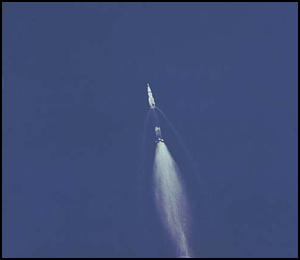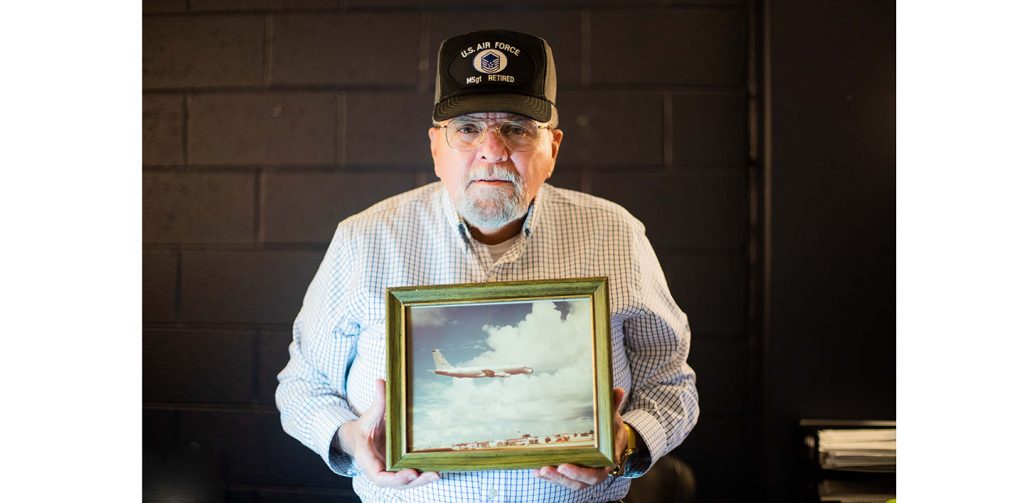David Bellows’ office in CASAS is similar to most of the rooms in the hallway where he works as the Director of Applied Studies – Testing Center.
But on a shelf nearby Star Wars memorabilia, lies an O-negative blood donor card signed by Gemini 11 astronauts Pete Conrad and Dick Gordon who have the same blood type–and an Apollo flight suit patch.
“We wore this patch when we flew for NASA,” Bellows said.
After graduating from high school in 1965 and joining the U.S. Air Force, Bellows was stationed at Patrick air force base in Florida. He became a timing record operator on one of eight advanced range instrumentation aircrafts (ARIA). These airplanes, nicknamed the “Droop Snoot,” were EC-135N aircrafts fitted with a 7-foot antenna on the front that could track missiles.
Bellows’ job has now been replaced by the over 2,000 satellites orbiting the earth, but for Apollo astronauts on missions to and from the moon, the aircraft he flew on was crucial. While astronauts were travelling through space, Bellows and his 20 fellow crew members were in the air, recording timing, medical and capsule data from the astronauts and the space craft.
They were also the earpiece between the astronauts and mission control center.
“We were what you would call a flying voice relay platform,” Bellows said. “[The astronauts] would communicate to us, and then we would communicate to NASA headquarters.”
The aircrafts were especially critical during the launch, trans-lunar injection and re-entry stages of the lunar missions.
While on mission, the aircrafts were stationed around the world filling in the gaps between land-based tracking stations to provide near constant data recording and communication with the astronauts, except while they passed behind the far side of the moon.
During the Apollo 8 flight, the first mission to orbit the moon, Bellows was stationed in Johannesburg, South Africa. During the Apollo 16 flight, the fifth lunar landing, he was stationed in Hawaii to photograph re-entry.
“We would stay available until they reached the moon, then we could come home while other planes would go out, and change clothes, pack up, and head out for [the spacecraft] coming back,” Bellows said.
After the rupture in the oxygen tank during Apollo 13, his crew worked 24 hours a day in shifts.
“We were getting ready for them coming back because no one knew what was going to happen, and (whatever happened) could be the thing that destroyed the Apollo program,” Bellows said.
Bellows was also a part of the crew with an Airborne Lightweight Optical Tracking System camera attached to the cargo door of the aircraft that captured a photo of the Saturn V rocket separation during the Apollo 11 launch.
“It was awesome to be part of it and to know you were, even though a small thing in it, you were a part of the reason that they were successful,” Bellows said.
In the 1970s, Bellows’ flight suit also displayed a Voyager patch. NASA employed the ARIAs to track the launch of the Voyager space probes that continue to send information back to earth about the outer edge of the solar system.

While NASA was the crew’s top priority, the technology was not limited to tracking spacecraft.
“It doesn’t matter what it is,” Bellows said. “As long as we can record it, we can tell people what’s going on.”
In the interval between the regularly scheduled NASA launches in the late 1960s, the crews helped with other projects, many of them classified. Bellows was on a team that tracked data from air launch cruise missiles shot from Boeing B52s, strategic bombers that can carry nuclear warheads.
Bellows is also one of the few Air Force personnel who never served in the Navy but is authorized to wear a Navy ribbon decoration for his support on the Polaris and Poseidon Missiles that added new developments in the accuracy of nuclear warheads.
By the time he retired from the Air Force in 1986 as a master sergeant, Bellows had accumulated over two years of time in the air.
Following retirement, Bellows attended Virginia Western Community College in Roanoke and received his associate degree in business data processing. After graduation, he worked for the Virginia Department of Transportation as a computer programmer for 13 years. In 2001, he began taking classes from Liberty University, where he graduated in 2004 with a degree in biblical studies and in 2010 with his master’s in religion and church ministries.
In 2010, Bellows joined the faculty at Liberty where he has worked since. He has taught classes in time management and study skills.
While he is no longer in the air, tracking missiles or connecting astronauts with mission control, the skills he learned, especially attention to detail, still apply to his work in the testing center.
“If someone came to me and said, ‘I’ve got the power to put you back to any age you want to be, what age do you want to be?’ I would say, ‘This one, right here,’” Bellows said.
Jacqueline Hale is the Feature Editor. Follow her on Twitter at @HaleJacquelineR.
